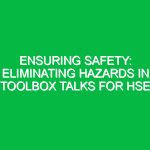Introduction
In today’s fast-paced industrial environment, the phrase “manage risk” resonates deeply within the Health, Safety, and Environment (HSE) domain. Effective risk management is not just a regulatory requirement; it is a vital practice that safeguards employees, assets, and the environment while ensuring the continuity and reputation of organizations. Managing risk involves identifying, assessing, and mitigating potential hazards that could lead to accidents, injuries, or environmental damage. This article delves into essential strategies for mastering risk management in HSE, providing insights and actionable advice for professionals across various sectors.
Understanding Risk Management in HSE
To effectively manage risk within the HSE context, it is crucial to understand its core components. Risk management encompasses a systematic approach to identifying risks, analyzing their potential impact, and implementing measures to mitigate or eliminate them. In HSE, this includes recognizing hazards such as chemical spills, electrical failures, ergonomic issues, and environmental concerns.
Key Aspects of Risk Management
1. Risk Identification
Identifying potential risks is the first step in managing risk. This can involve conducting regular safety audits, engaging employees in discussions about their concerns, and reviewing incident reports. For example, a manufacturing facility may discover that machinery malfunctions pose a significant risk to worker safety. Recognizing this risk allows the organization to take proactive measures.
2. Risk Assessment
Once risks are identified, the next step is assessing their likelihood and potential impact. This can be accomplished using qualitative or quantitative methods. A common approach is the risk matrix, which helps prioritize risks based on their severity and probability of occurrence. For instance, a company might categorize a chemical leak as a high-risk event due to its potential harm to employees and the environment.
3. Risk Mitigation
After assessing risks, organizations must implement strategies to mitigate them. This can include engineering controls, administrative policies, and personal protective equipment (PPE). For example, if a workplace is at risk of chemical exposure, providing proper PPE and training employees on safe handling procedures can significantly reduce potential harm.
4. Monitoring and Review
Risk management is an ongoing process. Regular monitoring and review ensure that risk mitigation strategies remain effective and relevant. Organizations should conduct periodic audits and solicit employee feedback to refine their approaches. An example can be seen in a construction company that regularly reviews its safety protocols after incidents to prevent future occurrences.
Essential Strategies for Effective Risk Management
1. Develop a Robust Safety Culture
Creating a culture that prioritizes safety is essential for effective risk management. Leaders should foster an environment where employees feel empowered to report hazards without fear of reprisal. Organizations can implement safety training programs that not only educate employees about risks but also encourage them to take an active role in managing safety.
2. Engage Stakeholders
Engaging all stakeholders, including management, employees, contractors, and even the community, is crucial. This collaborative approach ensures that diverse perspectives are considered in the risk management process. For instance, involving employees in safety committees can lead to innovative solutions that improve workplace safety.
3. Utilize Technology
Advancements in technology have transformed risk management practices. Tools such as data analytics, IoT sensors, and software applications can help organizations identify risks more efficiently and monitor safety performance in real-time. For example, a chemical processing plant might use sensors to detect gas leaks immediately, allowing for quick responses.
4. Implement Training Programs
Training is a critical component of risk management. Regular training sessions ensure that employees are aware of the risks associated with their tasks and understand how to mitigate them. For example, a construction company could conduct safety drills to prepare workers for emergencies, thereby reducing the likelihood of accidents.
Potential Hazards and Safety Considerations
Understanding potential hazards is integral to managing risk effectively. In the HSE context, hazards can be categorized into several types:
- Physical Hazards: These include slips, trips, falls, and equipment-related injuries.
- Chemical Hazards: Exposure to harmful substances can lead to serious health issues.
- Biological Hazards: This category includes risks from bacteria, viruses, and other microorganisms.
- Ergonomic Hazards: Poor workstation design can lead to musculoskeletal disorders.
- Environmental Hazards: Risks associated with pollution and environmental degradation.
Addressing these hazards involves not only implementing safety measures but also fostering awareness among employees regarding safe practices and the importance of reporting hazards promptly.
Regulations and Standards in Risk Management
In the realm of HSE, numerous regulations and standards govern risk management practices. Organizations must comply with these legal requirements to ensure safety and avoid penalties. Key regulations include:
1. Occupational Safety and Health Administration (OSHA) Standards
In the United States, OSHA sets forth standards that require employers to provide a safe working environment. Compliance includes conducting risk assessments, providing training, and maintaining records of safety incidents.
2. ISO 45001
This international standard for occupational health and safety management systems provides a framework for organizations to enhance employee safety and reduce workplace risks. Adopting ISO 45001 can help organizations systematically manage risks and improve safety performance.
3. Environmental Protection Agency (EPA) Regulations
The EPA enforces regulations to protect the environment from hazardous waste and pollution. Organizations must comply with these regulations to manage environmental risks effectively.
Conclusion
Mastering risk management in HSE is essential for creating a safe and sustainable work environment. By understanding the key components of risk management, implementing effective strategies, and adhering to regulations, organizations can significantly reduce accidents and enhance safety performance. Furthermore, fostering a culture of safety ensures that all employees are engaged and committed to managing risks proactively.
As industries continue to evolve, the importance of managing risk will only increase. Organizations that prioritize risk management not only protect their employees and the environment but also enhance their reputation and operational efficiency. In a world where safety cannot be compromised, mastering risk management in the HSE domain is not just a responsibility but a necessity.


